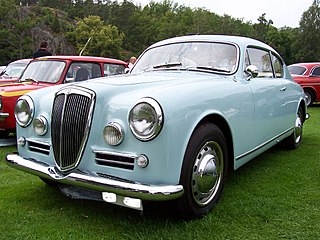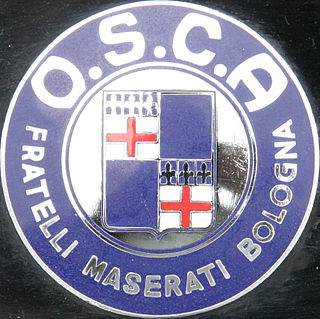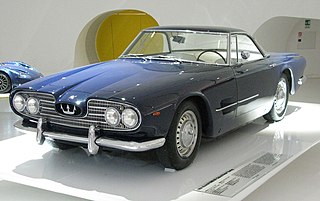
Giovanni Michelotti was one of the most prolific designers of sports cars in the 20th century. His notable contributions were for Ferrari, Lancia, Maserati and Triumph marques. He was also associated with truck designs for Leyland Motors, and with designs for British Leyland after the merger of Leyland and BMC.

The Volkswagen Karmann Ghia are a family of three overlapping sports car models produced by Volkswagen, marketed in 2+2 coupe (1955–1975) and 2+2 convertible (1957–1975) body styles, though German production ended one year before that in Brazil. Internally designated the Type 14 (1955–1975), the Type 34 (1962–1969), and the Type 145 TC, the Karmann Ghia cars combined the floorpans and mechanicals of the Type 1 / Beetle or Type 3 'ponton' models with styling by Italy's Carrozzeria Ghia, and hand-built bodywork by German coachbuilding house Karmann.

Pietro Frua was one of the leading Italian coachbuilders and car designers during the 1950s and 1960s.

A grand tourer (GT) is a type of car that is designed for high speed and long-distance driving with performance and luxury. The most common format is a front-engine, rear-wheel-drive two-door coupé with either a two-seat or a 2+2 arrangement. Grand tourers are often the coupé derivative of luxury saloons or sedans. Some models, such as the Ferrari 250 GT, Jaguar E-Type, and Aston Martin DB5, are considered classic examples of gran turismo cars.

Carrozzeria Ghia SpA is an Italian automobile design and coachbuilding firm, established by Giacinto Ghia and Gariglio as "Carrozzeria Ghia & Gariglio". The headquarters are located at Corso Guglielmo Marconi, 4, Turin. The company is currently owned by Ford Motor Company and focused on the European market through Ford's subsidiary in the region.

Ferrari America is a series of flagship grand touring Ferrari models primarily built for the North American market in the 1950s and 1960s. The America models were equipped with large V12 engines and often had custom bodywork done by famous coachbuilders in Italy. All America models used a live axle in the rear, were front-engined, and had worm and sector steering.

The Ferrari 250 is a series of sports cars and grand tourers built by Ferrari from 1952 to 1964. The company's most successful early line, the 250 series includes many variants designed for road use or sports car racing. 250 series cars are characterized by their use of a 3.0 L (2,953 cc) Colombo V12 engine designed by Gioacchino Colombo. The 250 series designation refers to this engine's cylinder displacement of approximately 250 cc. They were replaced by the 275 and 330 series cars.

Cisitalia was an Italian sports and racing car brand named after "Compagnia Industriale Sportiva Italia", a business conglomerate founded in Turin in 1946 by industrialist and sportsman Piero Dusio. One of the most memorable cars manufactured by the company was the 202 GT from 1946, which earned praise for its design and sold about 170 units.

The Lancia Flavia is an executive car produced by Italian automaker Lancia from 1961 to 1971.

O.S.C.A. was an Italian manufacturer of racing and sports cars established 1947 in San Lazzaro di Savena, Bologna, by the Maserati brothers, and closed down in 1967. The company name is usually written OSCA or Osca.

Maserati A6 were a series of grand tourers, racing sports cars and single seaters made by Maserati of Italy between 1947 and 1956. They were named for Alfieri Maserati and for their straight-six engine.

The Fiat 1300 and Fiat 1500 are a series of front-engine, rear-drive automobiles manufactured and marketed by Fiat from 1961 to 1967, replacing the Fiat 1400 and Fiat 1200 coupé, spyder and cabriolet. The 1300 and 1500 were essentially identical to each other except for their engine displacement, as indicated by their model names, and were offered in sedan/saloon, station wagon, convertible and coupé body styles which shared little mechanically with the other body styles except the 1500 engine.

The Fiat 1400 and Fiat 1900 are passenger cars produced by Italian automotive manufacturer Fiat from 1950 to 1958 and from 1952 to 1959 respectively. The two models shared body and platform, but while the 1.4-litre 1400 was Fiat's intermediate offering, the upmarket 1900 had an enlarged 1.9-litre engine and more luxurious trim and equipment, to serve as flagship in the manufacturer's range.

The Fiat 2300 is a six-cylinder executive car which was produced by Italian automotive manufacturer Fiat between 1961 and 1968. The 2300 was made as saloon, estate car and coupé. The 2300 saloon is noteworthy as in 1966 it became the first Fiat model to be available with an automatic transmission.

The Maserati 5000 GT is a 2-door coupé grand tourer, made by Italian automobile manufacturer Maserati from 1959–1966. A total of thirty-four were produced with bodies made by eight different Italian coach builders.

The Lancia Appia is a passenger car introduced in 1953 by Italian car manufacturer Lancia as a replacement for the Ardea, and which remained in production for ten years. The Appia was the last in a long line of Lancia production cars dating back to the Lancia Lambda to use sliding pillar front suspension. All three series produced had a 1089cc Lancia V4 engine.
The Turin Motor Show is an auto show held annually in Turin, Italy. The first official show took place between 21 and 24 April 1900, at the Castle of Valentino, becoming a permanent fixture in Turin from 1938 having shared it with Milan and Rome until that time. From 1972, the show was held biannually and in 1984, it moved into Fiat's shuttered Lingotto factory.

The Fiat-Abarth 750 is a compact sporting series of automobiles manufactured by the Italian manufacturing firm Abarth & C. of Turin, Italy in the 1950s and 1960s. The cars used the floorpan and often the bodywork of the Fiat 600 but were fitted with Abarth's modified engines. Abarth also offered a number of bodyworks by other designers for the 750 and its derivatives, most famously Zagato but also Allemano and others.

The Abarth 205A Berlinetta was a coupé sports car, also known as the Abarth 205A Monza built by Austrian born tuning expert Carlo Abarth in 1950. It was a development of the Abarth Cisitalia 204A but with a new platform chassis, still using the engine and other components from the Fiat 1100 B/E. Only three 205As were finished in 1950; chassis numbers 101, 102, and 103, but an additional car was built in 1953 with an extravagant Ghia body. Slow sales meant that for the next few years Abarth chose to focus on building his exhaust and tuning business, allowing competition and car manufacturing take a backseat. In 1955, the 205A was succeeded by the 207A Spyder and its derivatives.

Giovanni Savonuzzi was an Italian automobile designer who was born and died in Ferrara.






























